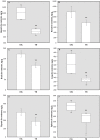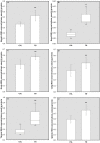Distribution of selenium and oxidative stress in breast tumor-bearing mice
- PMID: 23429470
- PMCID: PMC3635215
- DOI: 10.3390/nu5020594
Distribution of selenium and oxidative stress in breast tumor-bearing mice
Abstract
The present study investigated the effects of breast tumors on the blood and tissue distribution of essential trace mineral selenium (Se), and oxidative stress status of mice. Female 10-week-old BALB/cByJNarl mice were randomly assigned into control (CNL) and breast tumor-bearing (TB) groups. TB mice were injected subcutaneously into the right hind thigh with 5 × 10(6) EMT6 mouse mammary tumor cells. After 22 days, we measured Se concentrations, Se-dependent glutathione peroxidase (GPx) activities, and malondialdehyde (MDA) products (indicator of oxidative stress) in plasma, various tissues, and plasma vascular endothelial growth factor (VEGF) concentrations. There were no significant differences in body weights and daily intake between both groups. Compared with the CNL group, TB mice have decreases in plasma Se concentrations and GPx activities, as well as higher plasma VEGF and MDA concentrations. Plasma Se concentrations were also negatively correlated with plasma MDA and VEGF concentrations. Furthermore, tissue Se concentrations and GPx activities in TB animals were lower; whereas the MDA concentrations higher in various tissues including liver, kidney, brain, lung, spleen, and thymic tissues. In conclusion, disruption of Se homeostasis critically reflects oxidative stress in target tissues, thus may increase the risk for progression of breast cancer and metastasis.
Figures





References
-
- Ali A.N., Vapiwala N., Guo M., Hwang W.T., Harris E.E., Solin L.J. The impact of re-excision and residual disease on local recurrence after breast conservation treatment for patients with early stage breast cancer. Clin. Breast Cancer. 2011;11:400–405. - PubMed
-
- Chang K.J., Kuo W.H., Wang M.Y. The epidemiology of breast cancer in Taiwan. J. Chin. Oncol. Soc. 2008;24:85–93.
-
- Donadio A.C., Lobo C., Tosina M., de la Rosa V., Martín-Rufián M., Campos-Sandoval J.A., Matés J.M., Márquez J., Alonso F.J., Segura J.A. Antisense glutaminase inhibition modifies the O-GlcNAc pattern and flux through the hexosamine pathway in breast cancer cells. J. Cell. Biochem. 2008;103:800–811. doi: 10.1002/jcb.21449. - DOI - PubMed
Publication types
MeSH terms
Substances
LinkOut - more resources
Full Text Sources
Other Literature Sources

